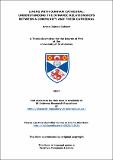Files in this item
Living with Durham Cathedral : understanding the dynamic relationships between a community and their cathedral
Item metadata
| dc.contributor.advisor | Bunn, Stephanie | |
| dc.contributor.author | Calvert, Arran James | |
| dc.coverage.spatial | 252 p. | en_US |
| dc.date.accessioned | 2017-11-09T09:35:57Z | |
| dc.date.available | 2017-11-09T09:35:57Z | |
| dc.date.issued | 2017-06-29 | |
| dc.identifier.uri | https://hdl.handle.net/10023/12034 | |
| dc.description.abstract | Cathedrals today are no longer sites of just religious worship, they must be many things to many people such as tourist attractions, heritage centres, and meeting places. Today, Durham Cathedral in the north-east of England is home to almost 900 people engaged on site, of which almost 700 are volunteers. Add to that number over 700,000 visitors and about 1,700 religious services annually, and a complex image of life within Durham Cathedral begins to take shape. Drawing on 14 months of ethnographic fieldwork between August 2013 and September 2014, this thesis takes a phenomenological approach in exploring the dynamic relationships that exist between a 900-year-old building and those who regularly come into contact with that building. It will consider the complex negotiations that take place between the many parts of the community and the building in a constantly changing environment, and will focus on the role sound, light, time, and space play in the constant challenge of change and negotiation. Finally, it will consider how buildings are not only constructed but are also cultivated through being built and rebuilt, spaces negotiated and improvised, as well as filled with stories and memories. The importance of this research is not just in observing and understanding the types of change and negotiation that occur between a building and those who inhabit it, but also in understanding the altering roles of religious buildings as they cope with the changing demands of running a site of both historical and continuing social, religious, and financial pressures, Durham Cathedral is a place that gives space to differing communities, allowing people to find in the building what they need from the building and as a result of this, Durham Cathedral is not a place in which life happens, it is a place with which life happens. | en_US |
| dc.language.iso | en | en_US |
| dc.publisher | University of St Andrews | |
| dc.rights | Attribution-NonCommercial-NoDerivatives 4.0 International | * |
| dc.rights.uri | http://creativecommons.org/licenses/by-nc-nd/4.0/ | * |
| dc.subject | Social anthropology | en_US |
| dc.subject | Durham Cathedral | en_US |
| dc.subject | Phenomenology | en_US |
| dc.subject | Sound | en_US |
| dc.subject | Light | en_US |
| dc.subject | Time | en_US |
| dc.subject | Community | en_US |
| dc.subject | Architecture | en_US |
| dc.subject | Building | en_US |
| dc.subject | LEGO | en_US |
| dc.subject | Religion | en_US |
| dc.subject | Negotiation | en_US |
| dc.subject | Change | en_US |
| dc.subject | Built environment | en_US |
| dc.subject | Relationships | en_US |
| dc.subject | Heritage | en_US |
| dc.subject | Christianity | en_US |
| dc.subject | Memory | en_US |
| dc.subject.lcc | BX5195.D9D87C2 | |
| dc.subject.lcsh | Durham Cathedral | en |
| dc.subject.lcsh | Architecture and anthropology--England--Durham | en |
| dc.title | Living with Durham Cathedral : understanding the dynamic relationships between a community and their cathedral | en_US |
| dc.type | Thesis | en_US |
| dc.type.qualificationlevel | Doctoral | en_US |
| dc.type.qualificationname | PhD Doctor of Philosophy | en_US |
| dc.publisher.institution | The University of St Andrews | en_US |
The following licence files are associated with this item:
This item appears in the following Collection(s)
Except where otherwise noted within the work, this item's licence for re-use is described as Attribution-NonCommercial-NoDerivatives 4.0 International
Items in the St Andrews Research Repository are protected by copyright, with all rights reserved, unless otherwise indicated.


